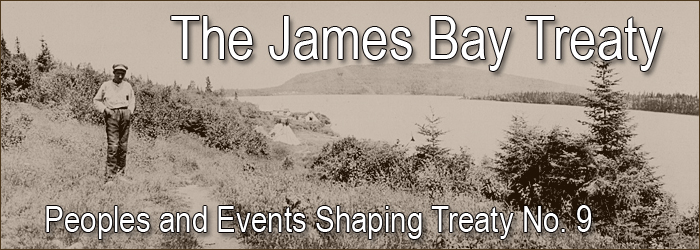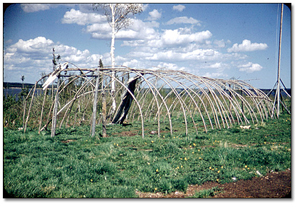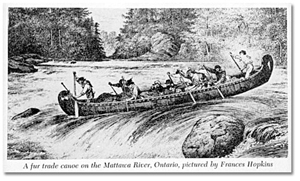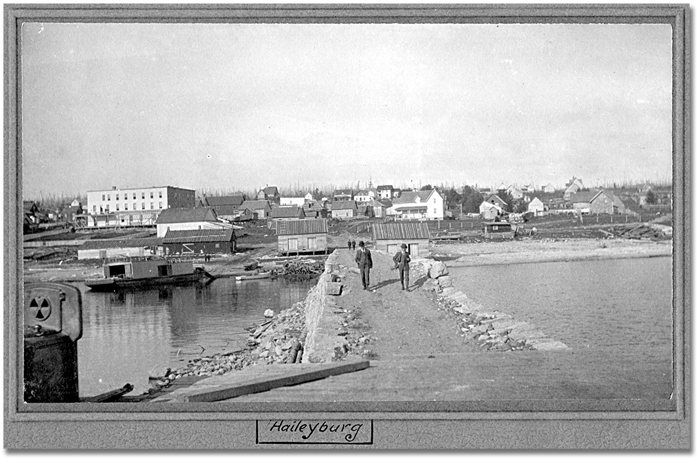
Table of Contents
Home | Peoples and Events Shaping Treaty No.9 | The Treaty No.9 Expedition of 1905-1906Developing the Treaty Relationship, 1905-2005 | The James Bay Treaty - Treaty No.9
Adhesions to Treaty No. 9 | 2013 Mushkegowuk Council Conference | About the Title Images

Click to see a larger image (117K)
Dancing and feasting lodge, Sandy Lake, 1956
John Macfie
Transparency
Reference Code: C 330-14-0-0-66
Archives of Ontario, I0012447
The ancestors of the present-day Nishnawbe Aski-Nation occupied what is now northern Ontario for thousands of years before Europeans. The Aboriginal peoples in the region are mainly Cree and Ojibway. Historically, the Cree lived mainly in the Hudson Bay and James Bay lowlands, while the Ojibway lived mainly in the interior.
Cree and Ojibway societies were well adapted to the ecological conditions on the lands they occupied. Traditional life followed yearly cycles of population dispersal and regrouping. In summer, people lived in larger camps located near shorelines, to access fisheries, waterfowl, and game.
Collecting wild fruits and plants supplemented dietary needs. In summer months, Ojibway and Cree leaders held political councils, and people travelled for trade, social and ceremonial purposes.
At the coming of winter, people dispersed into smaller groups of extended families and removed to hunting grounds in the interior.

In addition to archaeological sites, rock paintings provide visually striking evidence of Aboriginal occupation. Aboriginal pictographs depict various aspects of life, and of spiritual relationships to animals and places.
Mond Township between Mattagami Lake
and Matachewan, September 26, 1958
John Macfie
Transparency
Reference Code: C 330-14-0-0-189b
Archives of Ontario, I0012818

Click to see a larger image (80K)
Photograph of a drawing entitled, A fur trade
canoe on the Mattawa River, Ontario,
pictured by Frances Hopkins
Photographer unknown
Black and white negative
Reference Code: S 18096
Archives of Ontario, I0014668
Between about 1670 and 1880, the fur trade defined the main basis of Aboriginal contact with Euro-Canadians. After 1821, the Hudson’s Bay Company gained a near trade monopoly in northern Ontario. This led the Company to play a key practical role in the making of Treaty No.9.
Moose Factory was one of the oldest and most important centres of the fur trade
in what is now northern Ontario. Originally founded in 1673, Moose Factory acted
as a regional administrative, supply and shipping centre for other posts built on
the tributaries of the Moose River.
![Photo: View of the old Factory House in Moose Factory, [ca. 1867]](pics/5078_moose_factory_700.jpg)
View of the old Factory House in Moose Factory, [ca. 1867]
Photographer unknown, possibly Bernard Rogan Ross or Charles G. Horetzky
Captain Traill Smith photograph collection
Black and white print
Reference Code: F 2179-2-0-0-22
Archives of Ontario, I0005078
The construction of the Canadian Pacific Railway in 1885 near the highest point of land defining the Hudson and James Bay watershed (and the southern boundary of Treaty No.9) signalled the beginning of a new phase of contact. Aboriginal people began to press the government for a treaty. Many of these people had relatives south of this boundary, who were signatories to the Robinson Treaties of 1850. The Ojibway and Cree north of the height of land wished to obtain economic security in the advent of impending Euro-Canadian settlement and development.

Click to see a larger image (243K)
The Village of Haileybury, September 6, 1905
Photographer unknown
Duncan Campbell Scott fonds
Black and white print
Reference Code: C 275-1-0-3 (S 7587)
Archives of Ontario, I0010739
By the early 1900s, several hamlets and small villages had been built along the rail line and in other areas near the height of land.
In the late 1890s, plans were made to extend railways and hydro-electric stations north of the James Bay watershed. At this time, the Dominion government began consultations with Ontario concerning a potential treaty agreement with the Aboriginal inhabitants of the region.
Home | Next
Peoples and Events Shaping Treaty No.9 | The Treaty No.9
Expedition of 1905-1906
Developing the Treaty Relationship, 1905-2005 |
The James Bay Treaty - Treaty No.9
Adhesions to Treaty No. 9 | 2013 Mushkegowuk Council Conference |
About the Title Images